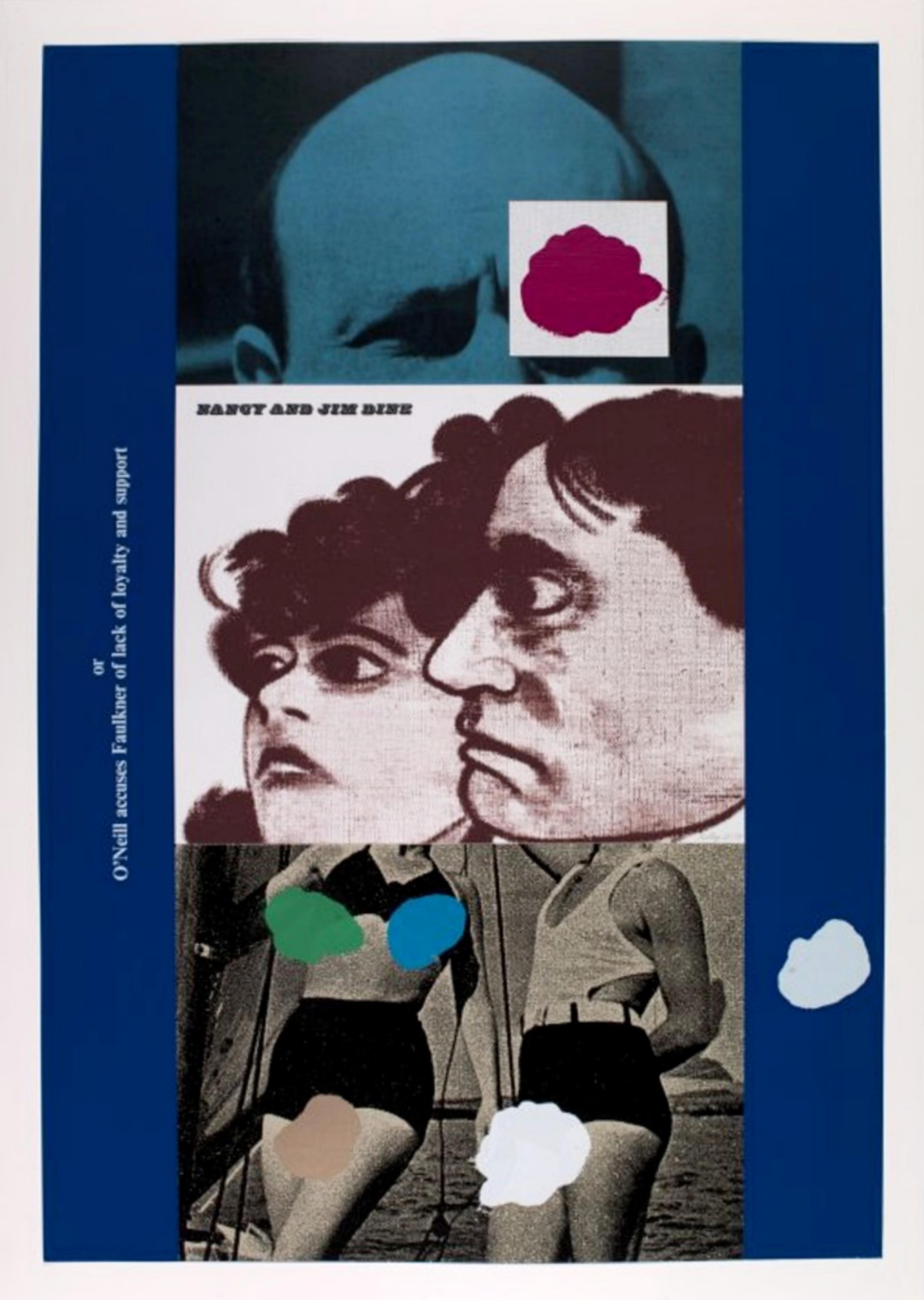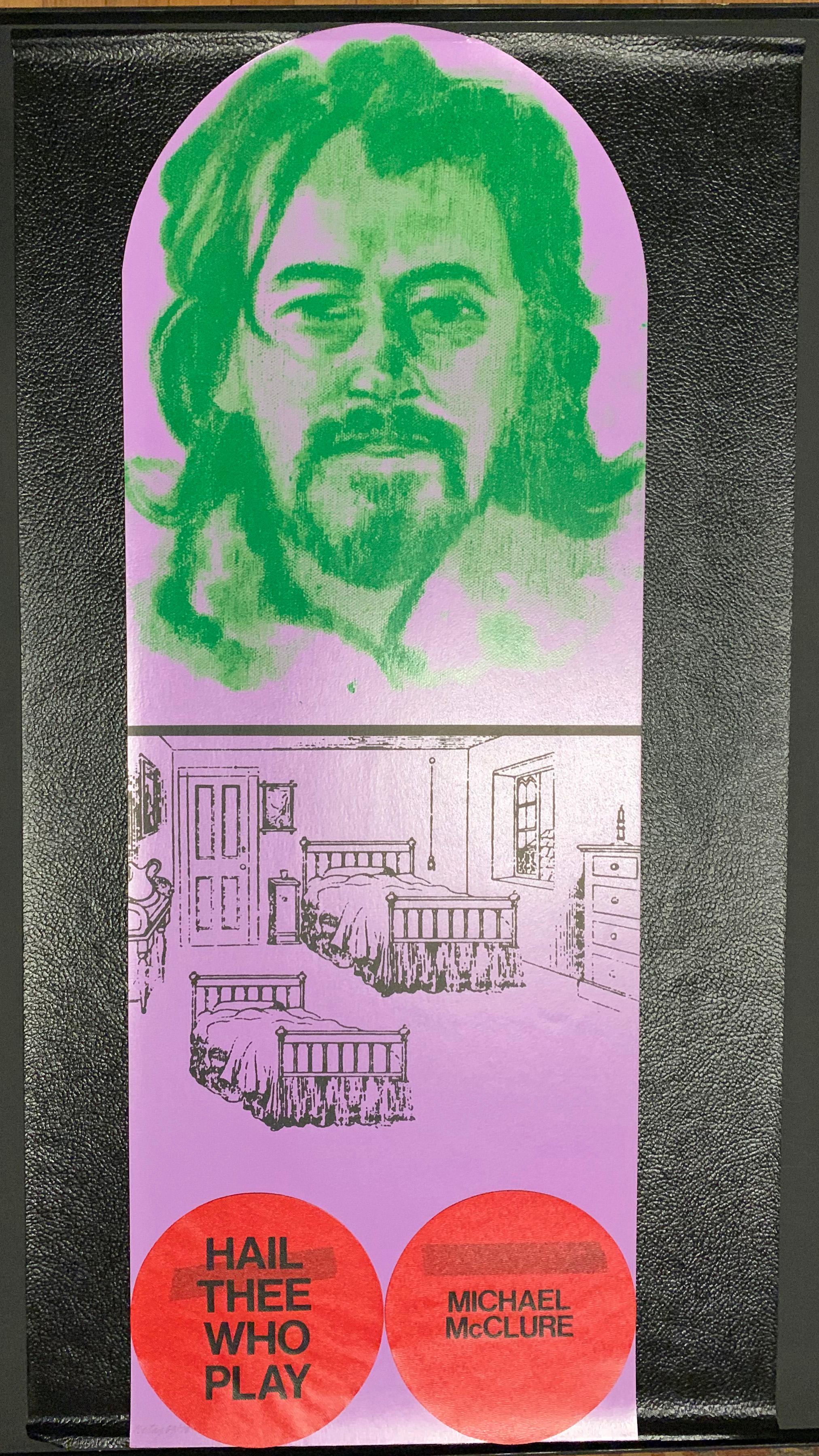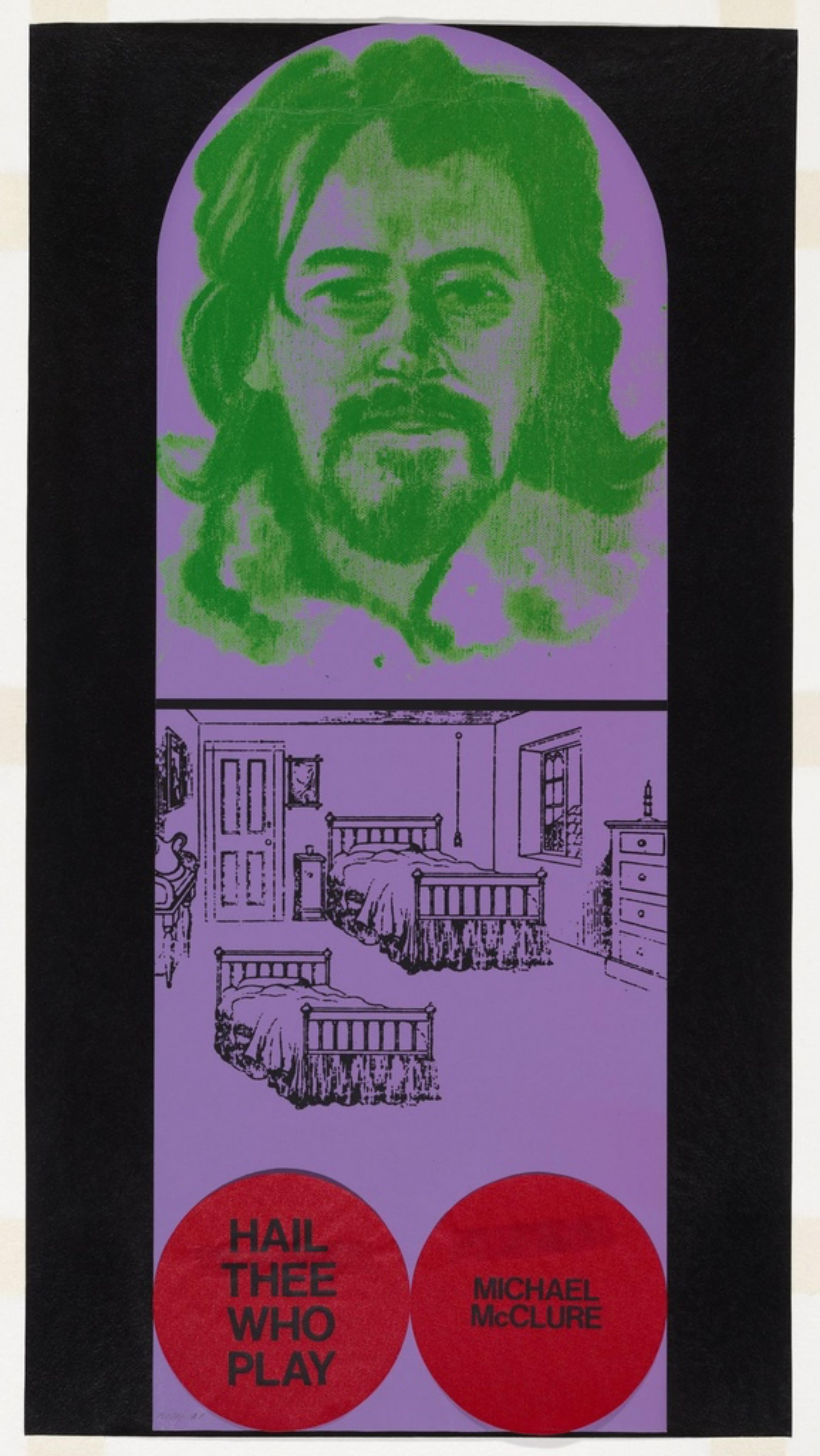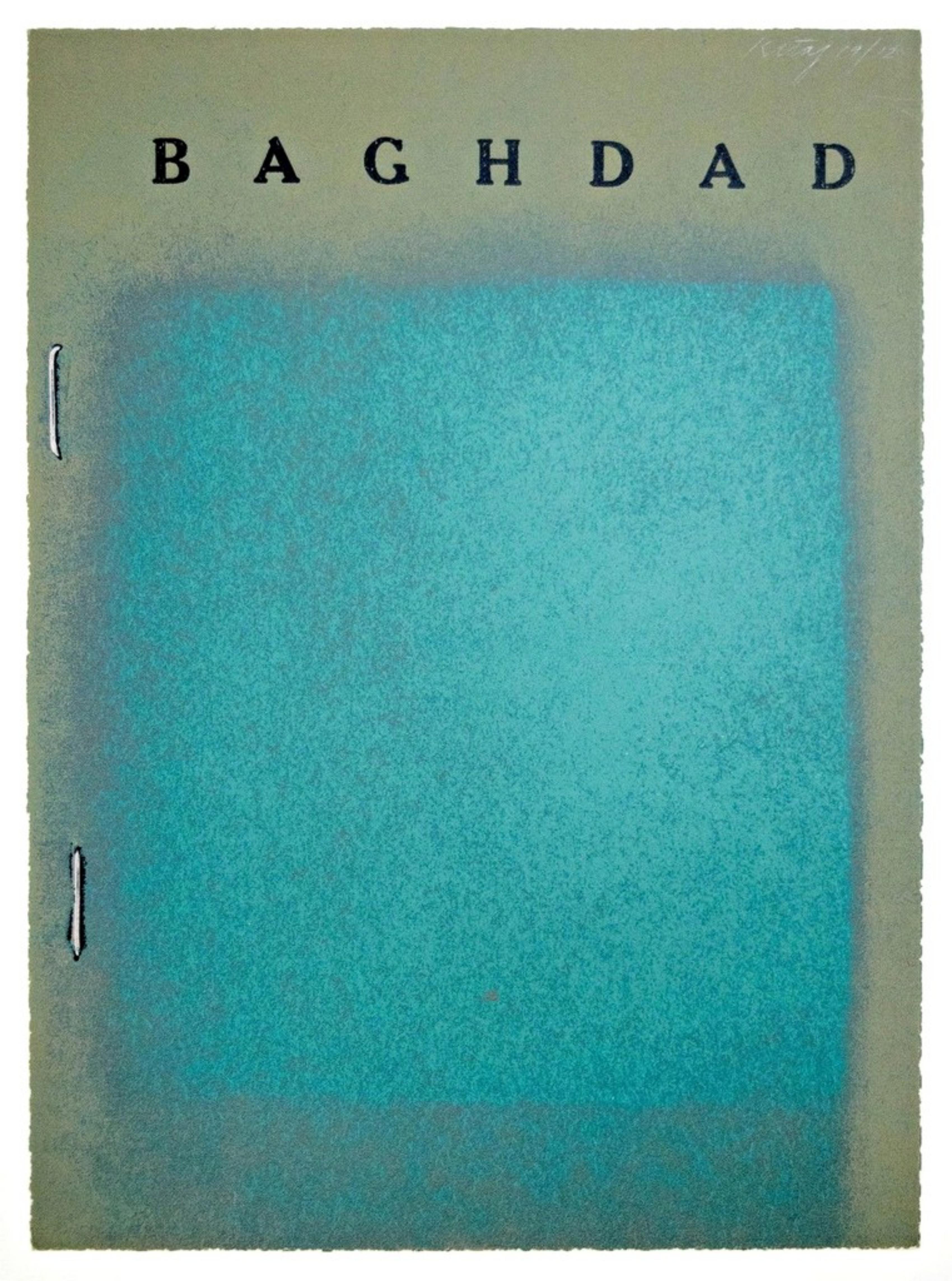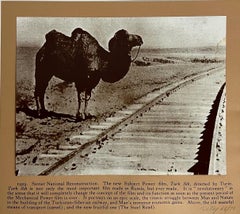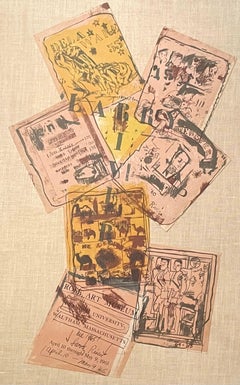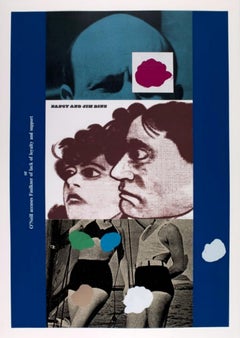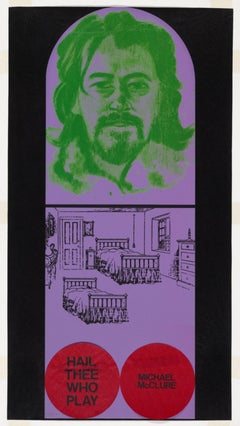Items Similar to R.B. Kitaj "The Jerwish Question"
Want more images or videos?
Request additional images or videos from the seller
1 of 6
Ronald Brooks KitajR.B. Kitaj "The Jerwish Question"1969
1969
$1,500
£1,139.29
€1,316.25
CA$2,102.30
A$2,352.87
CHF 1,228.02
MX$28,692.93
NOK 15,716.98
SEK 14,878.13
DKK 9,823.02
Shipping
Retrieving quote...The 1stDibs Promise:
Authenticity Guarantee,
Money-Back Guarantee,
24-Hour Cancellation
About the Item
Initialled signed in pencil From R. B. Kitaj, In Our Time: Covers for a Small Library After the Life for the Most Part, screenprint 1969 edition of 150 photo screenprint. A cover of the infamous Henry Ford book from the Dearborn Independent "The Jewish Question".
Printed by Kelpra Studio, London, published by Marlborough AG, Schellenberg, Florida. The Jewish Museum. a cover related to Russian Soviet cinema and film.
Stylistically, these are hybrid works, influenced by Pop art and the modernist tradition of the Readymade, a work of art created when a mundane found object is named as an artwork and set in an art context. This avant-garde concept was originally invented by the Dada master Marcel Duchamp early in the twentieth century. In the 1960s it received renewed attention at a time when artistic norms were again being questioned. Reacting to Andy Warhol’s Pop imagery, Kitaj poignantly called his repurposed book covers “his soup can, his Liz Taylor.” The blatant use of images taken directly from commercial sources situates In Our Time as a precursor of appropriation art. In turning book covers into works of art, Kitaj is offering fragments of a history of knowledge, in which the content of each volume is at once mysterious and absent. Coming from this passionate bibliophile, the series is nothing less than an intellectual self-portrait.
R.B. Kitaj, in full Ronald Brooks Kitaj . Ron Kitaj was born in Ohio, USA in 1932. American-born painter noted for his eclectic and original contributions to Pop art. He became a merchant seaman with a Norwegian freighter when he was 17. He studied at the Akademie der Bildenden Kunste in Vienna and the Cooper Union in New York. After serving in the United States Army for two years, in France and Germany, he moved to England to study at the Ruskin School of Drawing and Fine Art in Oxford and then the Royal College of Art in London, alongside David Hockney, Allen Jones and Patrick Caulfield. Kitaj was recognised as being one of the world's leading draftsmen, almost on a par with, or compared to, Degas. Indeed, he was taught drawing at Oxford by Percy Horton, himself a pupil of Walter Sickert, who was a pupil of Degas; and the teacher of Degas studied under Ingres.
Kitaj had a significant influence on British Pop art and was recognised as being one of the world’s leading draughtsmen. In his later years he developed a greater awareness of his Jewish heritage, considering himself to be a ‘wandering Jew’. He was awarded Royal Academician in 1991 and Golden Lion at the Venice Biennale in 1995. Examples of his work are held in most major public collections worldwide. Kitaj was elected to the Royal Academy in 1991, the first American to join the Academy since John Singer Sargent. He received the Golden Lion at the Venice Biennale in 1995. He staged another exhibition at the National Gallery in 2001, entitled "Kitaj in the Aura of Cézanne and Other Masters".
In September 2010 Kitaj and five British artists including Howard Hodgkin, John Walker, Ian Stephenson, Patrick Caulfield and John Hoyland were included in an exhibition entitled The Independent Eye: Contemporary British Art From the Collection of Samuel and Gabrielle Lurie, at the Yale Center for British Art.
Kitaj was associated with the beginnings of the Pop art movement in Great Britain in the early 1960s. His works mingled the impersonal finish characteristic of Pop canvases with the loose, painterly brushwork of Abstract Expressionism but differed from the work of his Pop contemporaries in their complex and allusive figurative imagery. Kitaj’s semi abstract paintings feature brightly coloured and imaginatively interpreted human figures portrayed in puzzling and ambiguous relation to one another. His work was highly intellectual in its wealth of pictorial references to historical, artistic, and literary topics. Kitaj continued to exhibit widely throughout the 1960s and ’70s while teaching painting at various British fine arts schools. In his later years, he developed a greater awareness of his Jewish heritage, which found expression in his works, with reference to the Holocaust and influences from Jewish writers such as Franz Kafka and Walter Benjamin, and he came to consider himself to be a "wandering Jew". In 1989, Kitaj published "First Diasporist Manifesto", a short book in which he analysed his own alienation, and how this contributed to his art.
He staged a major exhibition at Los Angeles County Museum of Art in 1965, and a retrospective at the Hirshhorn Museum in Washington D.C. in 1981. He selected paintings for an exhibition, "The Artist's Eye", at the National Gallery, London in 1980.
- Creator:Ronald Brooks Kitaj (1932-2007, American)
- Creation Year:1969
- Dimensions:Height: 19.97 in (50.7 cm)Width: 13.59 in (34.5 cm)
- Medium:
- Movement & Style:
- Period:
- Condition:
- Gallery Location:Surfside, FL
- Reference Number:1stDibs: LU38210505722
Ronald Brooks Kitaj
Born in Cleveland, Ohio in 1932, R.B. (Ronald Brooks) Kitaj is considered a key figure in European and American contemporary painting. While his work has been considered controversial, he is regarded as a master draftsman with a commitment to figurative art. His highly personal paintings and drawings reflect his deep interest in history; cultural, social and political ideologies; and issues of identity. Among his various honors are election to the American Academy of Arts and Letters in 1982, and election to the Royal Academy in 1985 (the first American since John Singer Sargent to receive this honor.) Numerous retrospective exhibitions of his work include shows at the Hirshhorn Museum in Washington, D.C.; The Jewish Museum, Berlin; The Jewish Museum, London; and the Hamburger Kunsthalle in Germany. Raised in Cleveland, Ohio, and Troy, New York, Kitaj joined the Merchant Marines in 1949.
In 1950, between sailings, he attended classes at the Cooper Union for the Advancement of Science and Art in New York. He went on to study drawing at the Academy of Fine Art in Vienna, Austria. Kitaj moved to Oxford, England in 1957, and enrolled at The Ruskin School of Drawing and Fine Art, University of Oxford. In 1959, Kitaj was accepted into Royal College of Art, London, where he befriended classmate David Hockney. Upon graduation from the RCA, Kitaj signed with Marlborough Fine Art, London, where he had his first solo exhibition in 1963. His art career began in earnest, and he found critical acclaim alongside commercial success. A second solo show followed at Marlborough Gallery, New York, in 1965, and he sold “The Ohio Gang” to The Museum of Modern Art. In 1969, Kitaj taught for a year at the University of California, Los Angeles. In 1976, he coined the term “School of London” in an essay he wrote as curator of the polemical exhibition, “The Human Clay,” at the Hayward Gallery, London. The term, though loose, continues to define a group of stylistically diverse artists, including Kitaj, who were working in London at that time focusing on figural representation. In 1981, he spent a year in Paris, France, where he focused on drawing and use of pastel. In 1994, the Tate Gallery, London, organized a major retrospective of Kitaj’s work. Hostile and personal attacks from some critics led to what Kitaj referred to as the “Tate War.” The exhibition subsequently traveled to the Los Angeles County Museum of Art and the Metropolitan Museum of Art, New York. Kitaj moved to Los Angeles, California, and continued to exhibit with Marlborough Fine Art and the Marlborough Gallery, New York. In 2001 the National Gallery London organized a solo exhibition of paintings: “R.B. Kitaj In the Aura of Cezanne and Other Masters.” Kitaj focused on his “late style” in his Yellow Studio in Westwood and died in 2007. His gift of his archive to the UCLA Library Special Collections was celebrated with exhibitions at the Skirball Cultural Center and UCLA’s Young Research Library.
About the Seller
4.9
Platinum Seller
Premium sellers with a 4.7+ rating and 24-hour response times
Established in 1995
1stDibs seller since 2014
1,782 sales on 1stDibs
Typical response time: <1 hour
- ShippingRetrieving quote...Shipping from: Surfside, FL
- Return Policy
Authenticity Guarantee
In the unlikely event there’s an issue with an item’s authenticity, contact us within 1 year for a full refund. DetailsMoney-Back Guarantee
If your item is not as described, is damaged in transit, or does not arrive, contact us within 7 days for a full refund. Details24-Hour Cancellation
You have a 24-hour grace period in which to reconsider your purchase, with no questions asked.Vetted Professional Sellers
Our world-class sellers must adhere to strict standards for service and quality, maintaining the integrity of our listings.Price-Match Guarantee
If you find that a seller listed the same item for a lower price elsewhere, we’ll match it.Trusted Global Delivery
Our best-in-class carrier network provides specialized shipping options worldwide, including custom delivery.More From This Seller
View AllR.B. Kitaj Screenprint Collage Hand Signed British Pop Art Film Still Camel
By Ronald Brooks Kitaj
Located in Surfside, FL
The Most Important Film Ever Made, 1972
Color screen print and collage, from the edition of 70.
15 x 17 in
38.1 x 43.2 cm
Published by the artist with Marlborough Graphics at the Kelpra studio in 1972. This work is also in the collections of TATE London and the Victoria & Albert Museum. the price reflects the fact that there is no backing page.
Stylistically, these are hybrid works, influenced by Pop art and the modernist tradition of the Readymade, a work of art created when a mundane found object is named as an artwork and set in an art context. This avant-garde concept was originally invented by the Dada master Marcel Duchamp early in the twentieth century. In the 1960s it received renewed attention at a time when artistic norms were again being questioned. Reacting to Andy Warhol’s Pop imagery, Kitaj poignantly called his repurposed lithograph and silkscreen book covers “his soup can, his Liz Taylor.” The blatant use of images taken directly from commercial sources situates In Our Time as a precursor of appropriation art. In turning book covers into works of art, Kitaj is offering fragments of a history of knowledge, in which the content of each volume is at once mysterious and absent. Coming from this passionate bibliophile, the series is nothing less than an intellectual self-portrait.
R.B. Kitaj, in full Ronald Brooks Kitaj . Ron Kitaj...
Category
1960s Pop Art Still-life Prints
Materials
Screen
Original Vintage Pop Art 1965 Collage Lithograph Larry Rivers Poster Brandeis
By Larry Rivers
Located in Surfside, FL
Larry Rivers
Modernist mixed media "Brandeis Show Collage" work on cut paper. (this appears to be a vintage lithograph. It has a label that describes it as watercolor and charcoal...
Category
1960s Pop Art Mixed Media
Materials
Lithograph
Israeli Expressionist Yosl Bergner Modernist Lithograph
By Yosl Bergner
Located in Surfside, FL
Hand signed in Hebrew Lower right. Dimensions: H 19.5" x 13.5"
Bergner, Yosl (Vladimir Jossif) (b Vienna, 13 Oct 1920). surrealist, surrealism. belongs to the generation of people...
Category
Mid-20th Century Modern Figurative Prints
Materials
Lithograph
Modernist Judaica Art Aquatint Etching Jewish Rabbi at Prayer Jerusalem Memories
By Lennart Rosensohn
Located in Surfside, FL
Swedish Jewish modern art. On Hahnemuhle paper, hand signed and numbered. poster is not included.
These depict synagogue interiors, Rabbis at prayer ...
Category
20th Century Modern Figurative Prints
Materials
Etching, Aquatint
Judaica Imagery on Wood Contemporary Pop Art Manner
Located in Surfside, FL
A silkscreen mixed-media work that exhibits the word "Forefathers" in Hebrew across the bottom of the piece.
Category
Late 20th Century Contemporary Mixed Media
Materials
Wood, Mixed Media, Acrylic, Black and White
Surrealist Abstract Hebrew Shabbat Pop Art Silkscreen Judaica Jewish Serigraph
By Jozsef Jakovits
Located in Surfside, FL
Abstract Hebrew Prints on heavy mould made paper from small edition of 15. there is a facing page of text in Hungarian folded over. Hard edged geometric abstract prints in color base...
Category
1980s Pop Art Abstract Prints
Materials
Archival Paper, Screen
You May Also Like
O'Neill accuses Faulkner of lack of loyalty and support (Nancy & Jim Dine)
By R.B. Kitaj
Located in New York, NY
Ronald B. (R.B.) Kitaj
Nancy and Jim Dine, or O'Neill accuses Faulkner of lack of loyalty and support (Kinsman 40), 1970
16 Color Silkscreen with collage and coating on different wove papers
Hand signed and numbered in pencil 29/70 on the front. The back (which is framed) bears the Kelpra Studio blindstamp
Frame included: held in the original vintage metal frame
Very rare stateside. Other editions of this work are in the permanent collections of major institutions like the British museum, which has the following explanation: "The artist Jim Dine and his wife Nancy were close to Kitaj and his family, especially after the death of Elsi, Kitaj's first wife in 1969. They sometimes stayed with the Dines at their farm in Vermont during Kitaj's second teaching sojourn in the United States. Dine and Kitaj held a joint show at the Cincinnati Museum of Art in 1973. In the catalogue both artists contributed an insightful 'essay' on each other with Dine stressing Kitaj's obsession with all things American and baseball-related...' The alternate title, "O'Neill accuses Faulkner of lack of loyalty and support" can be seen on the artwork itself, and clearly is some kind of inside joke among friends. By the way -- do you see the way the colored dots are placed over the figures? Kitaj was doing this well before Baldessari who made it famous; that's how pioneering he was at the time.
Referenced in the catalogue raisonne of Kitaj's prints, Kinsman, 40
Published and printed by Chris Prater of Kelpra Studio, Kentish Town, United Kingdom
Ronald Brooks (RB) Kitaj Biography
R.B. (Ronald Brooks) Kitaj was born in 1932 in Cleveland Ohio. One of the most prominent painters of his time, particularly in England where he spent some four decades spanning the late 1950s through the late 1990s, Kitaj is considered a key figure in European and American contemporary painting. While his work has been considered controversial, he is regarded as a master draughtsman with a commitment to figurative art. His highly personal paintings and drawings reflect his deep interest in history; cultural, social and political ideologies; and issues of identity.
Part of an extraordinary cohort who emerged from the Royal College of Art circa 1960, which included Peter Blake, Patrick Caulfield, and David Hockney, Kitaj was immediately pegged as one of its leading figures. The London Times greeted his first solo show in 1963 as a long-awaited and galvanizing event: “Mr. R.B. Kitaj’s first exhibition, now that it has at last taken place, puts the whole ‘new wave’ of figurative painting in this country during the last two or three years into perspective.” In 1976, KItaj curated the exhibition The Human Clay, and in the essay he wrote for it he proposed the existence of a “School of London”—a label which stuck to a group of painters that includes Francis Bacon, Frank Auerbach, Lucian Freud, Leon Kossoff, Michael Andrews...
Category
1970s Pop Art Portrait Prints
Materials
Mixed Media, Screen, Pencil
FIRST SERIES - SOME POETS.
By Ronald Brooks Kitaj
Located in Portland, ME
Kitaj, R. B. FIRST SERIES - SOME POETS. Marlborough AG, Schellenburg, FL, 1970. Number 69 of the edition of 70 (there were about 15 additional proofs for the Artist, the Printer, and...
Category
1970s Figurative Prints
Materials
Screen
In Our Time - China of Today, Print by Ronald Brooks Kitaj
By Ronald Brooks Kitaj
Located in Long Island City, NY
Artist: R. B. Kitaj, American (1932 - 2007)
Title: In Our Time - China of Today
Year: 1970
Medium: Screenprint, signed 'RK' in pencil
Edition: 150
Image Size: 18 x 23 inches
Size: 22...
Category
1970s Conceptual Abstract Prints
Materials
Screen
Hail Thee Who Play (Michael McClure), silkscreen collage, signed/n Kinsman, 1994
By R.B. Kitaj
Located in New York, NY
R.B. Kitaj
Hail thee who play (Michael McClure), 1969
Silkscreen, photo-silkscreen and collage on black textured paper
33 × 13 9/10 inches
Edition 35/70
Pencil signed and numbered on...
Category
1960s Pop Art Figurative Prints
Materials
Mixed Media, Screen
R.B. Kitaj, The cultural value of fear, distrust and hypochondria, 1964-1966
By Ronald Brooks Kitaj
Located in San Francisco, CA
ABOUT
R.B. Kitaj, The cultural value of fear, distrust and hypochondria. Screenprint
Edition of 70
Signed in pencil lower right.
Unframed.
Color lithograph on different types of pa...
Category
Mid-20th Century British Folk Art Contemporary Art
Materials
Paper
BAGHDAD Six color screenprint, renowned British Pop pioneer R.B. Kitaj, Signed/N
By Ronald Brooks Kitaj
Located in New York, NY
Ronald Brooks (R.B.) Kitaj
BAGHDAD, 1972
Six Color Screenprint and Photoscreenprint
20 × 14 1/2 inches
Pencil signed and numbered 1/125
Printed at Kelpra Studio, London
Published by ...
Category
1970s Pop Art Abstract Prints
Materials
Screen
More Ways To Browse
Golden Lion
Lion Art By England
Ronald B Kitaj
Warhol Jews
David Hockney Flowers
Hockney Ipad Drawings
17th Century Engravings Of Flowers
Andy Warhol Flowers 1970
Louise Abrams
Lowell Nesbitt Iris
Watermelon Print
Antique Botanical Prints Australia
Vintage Magnolia Prints
Gladiolus Flower
Steven Kenny
Hunt Slonem Serigraph
Cathelin Bernard
Cape Of Good Hope Art
